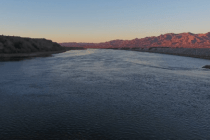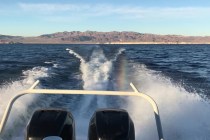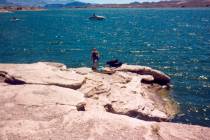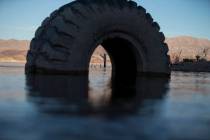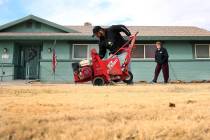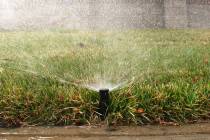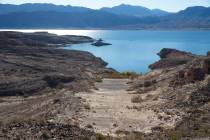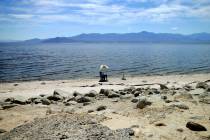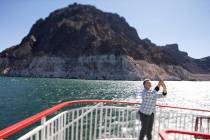hen representatives from seven Western states met in Santa Fe, New Mexico, to divvy up the Colorado River in 1922, Las Vegas was a dusty railroad stop with fewer than 2,500 residents.
No one could have imagined this isolated desert community would one day become an international destination with more than 2 million residents and 40 million annual visitors.
No one thought Nevada would ever need more water than it eventually got from those early Colorado River negotiations.
“It strikes me as a forgivable failure of imagination,” said historian Christian Harrison, who earned his doctorate from UNLV. “They probably thought they would land people on Mars before we had so many people living in this valley.”
The concessions Nevada made at those negotiations in New Mexico almost a century ago now threaten to limit future growth in the state’s largest community, where 90 percent of the water supply comes from a river teetering on the brink of shortage.
Nevada and the other six states that rely on the river for water face a federal deadline of March 19 to submit plans to voluntarily reduce their use ahead of an unprecedented shortage declaration that could come later this year and bring additional, mandatory cuts aimed at keeping Lake Mead from crashing.
Water was such an afterthought in 1920s Clark County that Nevada’s representatives in the negotiations happily accepted the smallest share of the Colorado in exchange for what they were really after: construction jobs, tax revenue and access to cheap electricity from soon-to-be-built Hoover Dam.
“Nevada was the first to ratify the (Colorado River) compact. They wanted the power, and they wanted the dam site,” Harrison said.
So when tiny Nevada received its tiny allotment of river water — 300,000 acre-feet a year, compared with 2.8 million for Arizona and 4.4 million for California — state officials and civic leaders barely batted an eye.
Link to the lake
Who could blame them?
When construction of Hoover Dam began in 1931, fewer than 100,000 people lived in Nevada, and most of them were in the northern half of the state, far beyond the river’s reach. Clark County, population 8,500, was home to some mines, a few modest farming operations and a newly legal gaming industry, but nothing that seemed to require a major new source of water or the means of delivering it.
“There’s nobody here,” Harrison said. “Who in their right mind is going to pay for the infrastructure” to pipe water into the valley from Lake Mead?
That question eventually found its answer in the dizzying growth Las Vegas experienced during and after World War II.
Clark County’s population more than doubled between 1940 and 1950, then tripled between 1950 and 1960 to just over 127,000. It would double or nearly double every decade after that.

(Severiano del Castillo Galvan/Las Vegas Review-Journal)
According to some estimates, the Las Vegas Valley outgrew its local groundwater supply in the late 1940s, but the community kept drilling wells and powering pumps for decades after that. By the time the community sank its first straw into Lake Mead in 1971, the free-flowing springs that attracted Las Vegas’ first settlers had been drained dry, and the ground above the valley’s depleted aquifer had begun to crack and sink in places.
The ability to draw water from Lake Mead changed everything — and quickly. Within a few decades, Las Vegas went from using no Colorado River water at all to being dependent on the river for 90 percent of its total supply.
That’s when the folly of the 300,000-acre-foot river allotment finally began to register.
“It was very late when we realized we weren’t going to have enough water,” Harrison said.
The task of solving that problem fell to a career bureaucrat whose background included a master’s degree in German literature from UNLV and a stint as Clark County’s first justice court administrator.
Pat Mulroy inherited a mess when she took over as general manager of the Las Vegas Valley Water District in 1989.

Former General Manager of the Southern Nevada Water Authority Pat Mulroy in 1996. (Review-Journal file)
“All of the valley had become painfully aware that we were running out of water pretty quick,” said Mulroy, now a senior fellow at UNLV’s Boyd Law School and the Brookings Institution. “We had way more commitments than we had water with which to satisfy those commitments, and no way to pull them back.”
She quickly oversaw two crucial, if controversial, moves: a temporary moratorium on water for new developments and a mass filing for unappropriated groundwater rights across rural Nevada to fill a proposed pipeline to Las Vegas that still has not been built.
Mulroy also worked to end years of “open warfare” among the valley’s water utilities, bringing the agencies together under one umbrella to share and stretch Nevada’s Colorado River allocation.
Under one umbrella
The formation of the Southern Nevada Water Authority in 1991, with Mulroy at the helm, gave the community a strong, unified voice to negotiate with other river users and collectively take on major infrastructure challenges that the individual utilities would have struggled to address.
But the single most important concept that came from the creation of the water authority is the “return-flow credit” — an all-important marker issued by federal regulators that allows the community to draw an extra gallon of Colorado River water for every gallon of wastewater it treats and returns to Lake Mead.

The Nevada intake towers under construction at Hoover Dam. (Library of Congress)
The arrangement allows the Las Vegas Valley to effectively recycle almost every drop of water that enters the sewer system. It turns the water from every flush, shower, dishwasher cycle or laundry load into a renewable resource.
“We knew we had to bring additional water to bear,” said Mulroy, who retired from the district and the authority in 2014. “Until you created SNWA, the federal government had nobody to contract with who could be held accountable for all water and wastewater in Southern Nevada. Until you had SNWA, no contract for return-flow credits was possible. That was the whole point.”
A few other cities on the river also use return-flow credits to stretch their water resources, but Las Vegas is unique in returning such a high percentage of its intake to the source and reusing it.
It’s hard to overstate how important that is for Southern Nevada, according to Colorado River expert John Fleck, director of the University of New Mexico’s Water Resources Program in Albuquerque. With the ability to fully recycle so much of its water, Fleck said, “Las Vegas has control over its own destiny.”
Watch: How did we get here?
The end of the 20th century also saw new levels of cooperation among the seven river states, including a landmark deal that allowed Nevada to bank water in Arizona and sweeping new guidelines for dividing surplus river water among Nevada, Arizona and California.
Mulroy said the year 2000 ended in a rare moment of optimism for Western water managers, with Lake Mead close to full and a new agreement in hand that guaranteed extra water for Southern Nevada and other rapidly growing communities served by the famously fickle river.
The authority was counting on that agreement — and the surplus water it was expected to provide — to serve the community’s growing thirst for 15 years at least. Mother Nature had other ideas.
“We were looking forward to a water future exclusively from the Colorado River,” Mulroy said. “Little did we know the day the ink dried on that document, the drought would begin.”
Contact Henry Brean at hbrean@reviewjournal.com or 702-383-0350. Follow @RefriedBrean on Twitter.

Construction of Hoover Dam. (Library of Congress)
A founding father’s folly
Nevada has been stuck with a paltry, 300,000 acre-foot annual share of the Colorado River since 1928, when President Calvin Coolidge signed the Boulder Canyon Project Act authorizing construction of Hoover Dam. But where did that crucial, cursed number come from?
One of Las Vegas’ founding fathers claims to have puzzled it out back-of-a-napkin style, according to a document unearthed from UNLV special collections by historian Christian Harrison.
Charles Pember Squires was a newspaperman and early civic booster who followed the railroad to Las Vegas in 1905 and wound up appointed by the governor to represent Nevada on issues relating to the proposed dam on the Colorado River.
In his typewritten recollections preserved at UNLV, the man known to locals as “Pop” Squires said Nevada’s interests in the river were “very small” and “not hard to settle.” Someone asked him how much water the state would need from the Colorado, and he replied with “a quick calculation”: maybe 75,000 acres of good land in the Las Vegas Valley and “none elsewhere,” 4 acre-feet of water a year for each of those acres, “that would be say 300,000 acre-feet per annum.”
“Seemed all right,” Squires concluded. The rest is history.



